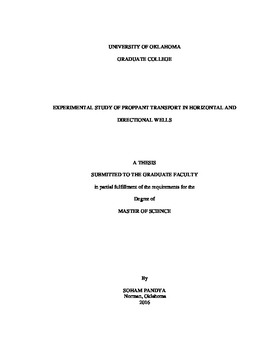| dc.description.abstract | Wellbore cleanouts represent the main application of the coiled tubing (CT) industry. A typical cleanout operation designed to remove solids from the wellbore using stationary circulation method involves tripping the CT to a target depth, and circulating the fluid to erode the solids bed and suspend particles into the flow stream up to the surface. Theoretically, the wellbore can be cleaned out completely by circulating a high density fluid at very high flow rates. However, this would result in high bottom-hole pressure that may exceed the fracture pressure of the formation. Thus, the circulation process is associated with limitations of maximum achievable flow rate and equivalent circulating density of the fluid. Hole cleaning is a function of multiple variables including but not limited to fluid properties, flow rate and wellbore deviation. The efficiency of hole cleaning operation is crucial to the industry. Therefore, we seek answers to how these variables influence the hole cleaning efficiency.
Efficiency of fluid was quantitatively studied by bed erosion tests conducted in a 34 ft test section of 5½-in. OD (5-in. ID) outer transparent pipe and 2.375-in. OD inner tubing. The reduction in bed height as a function of circulation time, fluid rheology, flow rate, and wellbore inclination was investigated. Fluids incorporated in this study were water, and 10 lbm/Mgal and 20 lbm/Mgal Guar fluids. Proppant used in the study was light-weight 20/40 mesh size ceramic proppant. Proppant bed was deposited using freshwater. Bed erosion was carried out at flow rates from 80 to 120 gpm and within inclination of 45° to 90°.
To quantitatively describe proppant transport efficiency, two parameters were used as the target variables in this study –
i. Normalized Bed height: indicates the vertical height of the stationary proppant bed in the annulus with respect to the initial vertical bed height.
ii. Cleanout efficiency: measure of the weight percentage of proppant cleaned out of the test section at end of 30 minutes.
Bed erosion curves were generated to analyze the data with respect to the reduction in bed height with time for various parameters. Efficiency plots were analyzed to determine the range of critical inclination within which efficiency of all fluids is similar. An important consideration in designing cleanout operations is the proper selection of the pump rate and circulation fluid. Higher turbulence generated by low viscosity fluid (water) assisted in better lift of particles from the stationary bed. However, higher viscosity fluids tend to transport particles in the flow stream to a greater distance due to its greater carrying capacity. It was observed that the low viscosity fluids like water performed better at higher inclinations whereas, higher viscosity fluids performed better at lower inclinations due to their relatively superior particle carrying capacity. In general, it is recommended that cleanouts should be conducted using high viscosity fluids for wellbore inclination less than 70° (critical inclination). Experimental results were analyzed by non-linear regression technique to establish a functional relationship among different parameters. Empirical bed decay model was developed to incorporate the effect of change in circulation time, flow rate, and fluid rheology for each inclination. Field application of the developed correlation can aid in optimized cleanout practices. | en_US |
